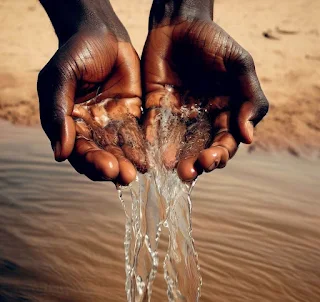Drinking Fossil Water From The Nubian Aquifer
The Nubian Aquifer spans four African countries and covering 965,255 sq miles.
The Nubian Aquifer, one of Africa's most significant water resources, with its immense size, spans over 965,255 square miles extending across four countries, Egypt, Chad, Libya, and Sudan; the aquifer serves as a lifeline for communities living in the Eastern Sahara Desert.
Fossil water, also called paleowater or ancient water, has undergone natural filtration and protection from modern contaminants for a considerable time, ranging from 66 to 145 million years ago. This prolonged confinement underground in aquifers has contributed to its purity and general safety for drinking.
Water in the Eastern Sahara Desert is a precious and scarce resource due to the region's extreme aridity and limited rainfall. The Eastern Sahara Desert, also known as the Libyan Desert, is part of the larger Sahara Desert, the world's largest hot desert covering much of North Africa.
The Eastern Sahara receives very little rainfall throughout the year, and surface water sources, such as rivers and lakes, are scarce or nonexistent in most areas. Some oases in the Eastern Sahara rely on fossil water from ancient aquifers like the Nubian Aquifer.
However, the very characteristic that makes the Nubian Aquifer so valuable, its fossil water nature, also puts it at risk. This groundwater has been trapped underground for thousands of years, dating back to the last Ice Age and beyond. Its non-renewable status on human timescales raises serious concerns about its continued availability and sustainable use.
Discovery of the Nubian Aquifer
The discovery of the Nubian Aquifer can be attributed to geological explorations and scientific investigations that aimed to understand the groundwater resources in the region. As the aquifer is an underground water reservoir, its discovery was not a singular event but rather a gradual process involving several scientists and researchers.
The term Nubian Aquifer or Nubian Sandstone Aquifer System is not attributed to a single person but rather a descriptive name given based on the geographic location and the type of aquifer rock. The Nubian Aquifer spans across the Nubian Desert region, which is part of the larger Sahara Desert and is primarily composed of porous sandstone formations that hold the fossil water.
The realization that the Nubian Aquifer's water is fossil water, dating back thousands of years and essentially non-renewable, came from extensive hydrogeological studies and research conducted over time. As scientists delved deeper into understanding the aquifer's characteristics, they gradually pieced together the timeline of the water's presence and the limitations of its recharge rate.
Due to its vastness and its shared presence across multiple countries, the discovery and study of the Nubian Aquifer involved the collaboration of researchers and experts from Egypt, Chad, Libya, and Sudan. Over the years, hydrologists, geologists, and researchers from various institutions and international organizations have contributed to studying the Nubian Aquifer, shedding light on its significance, limitations, and the need for sustainable management practices.
Nubian Aquifer Fossil Water Source
Unlike replenishable water sources, fossil water cannot be naturally replenished within a relevant timeframe. The recharge rate is exceedingly slow and, in some cases, non-existent. This means that once the water is extracted from the aquifer, it cannot be replaced, leading to a gradual depletion of this invaluable resource.
The water in the Nubian Aquifer is considered fossil water because the formation of the Nubian Aquifer dates back to the late Cretaceous and early Tertiary periods, approximately 66 to 145 million years ago. During these periods, the region experienced wetter and more humid conditions, which allowed for water accumulation in the aquifer's porous sandstone layers.
Fossil water, also known as paleowater or ancient water, refers to groundwater that has been trapped underground for an exceptionally long period, often thousands or even millions of years. This water is considered fossil because it dates back to much earlier geological eras when climatic conditions were different from what they are today.
As a result, fossil water is essentially non-renewable on human timescales, as the rate at which water is replenished is exceedingly slow or, in many cases, non-existent. The Nubian Aquifer is at risk because once the water is extracted from the aquifer, it cannot be replenished within a human-relevant timeframe.
The Nubian Aquifer is a vital source of water in the arid and semi-arid regions of the Sahara Desert. It plays a critical role in providing water for drinking, agriculture, and other essential needs in the region. It lies beneath the Eastern Sahara Desert, making it a critical water source in an arid and semi-arid region. As scientific knowledge evolved and data on the Nubian Aquifer accumulated, understanding its fossil water nature became well-established.
Fossil Water is Generally Considered Safe to Drink
Fossil water, also known as paleowater or ancient water, is safe to drink because it has been naturally filtered and protected from modern contaminants over the course of thousands or even millions of years. Its long-term confinement underground in aquifers has contributed to its purity and safety for human consumption.
As the water slowly seeped through layers of porous rock, such as sandstone, it underwent natural filtration, removing impurities and contaminants. This process is similar to the natural filtration that occurs in modern groundwater systems.
Fossil water is shielded from surface contaminants, such as pollutants and modern-day industrial or agricultural runoff, as it has been isolated deep within the Earth for an exceptionally long time. However, in some cases, localized contamination can occur due to human activities or natural events. For example, the water's safety may be compromised if modern pollutants have infiltrated the aquifer due to poor waste disposal or industrial practices.
Did you know?
Two prominent examples of fossil reservoirs are the Nubian Aquifer in North Africa and the Ogallala Aquifer in the United States Central region. These underground water sources are important due to their ancient origins and the vast amounts of water they contain. The Nubian Aquifer is estimated to hold around 150,000 cubic kilometers of water, while the Ogallala Aquifer is believed to contain approximately 3 billion acre-feet of water. Both of these aquifers have played a crucial role in providing water to the surrounding regions and supporting agriculture and other industries.











